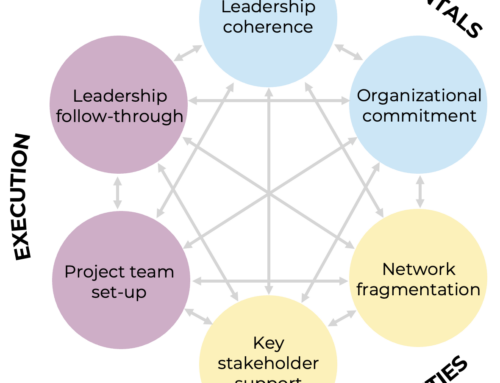SUCCEED WITH CHANGE
Social Change Only Happens Outside Your Own Echo Chamber
September 14th, 2023 | Succeed with change
Most social change never ignites, as we stick to seeking allies solely within our familiar circles. Our great efforts never reach anyone outside our own echo chamber. We only talk to people we know that are like us, and that are already convinced of our great objective. And then we fail!
In this article, I reflect on my experiences in social change and how I’ve come to realize the importance of recognizing the limits of your own influence. I will share the challenges I’ve observed and the solutions that can ignite impactful social change.
The Challenge: Staying within your Echo Chamber
One of the fundamental reasons we fail to create significant social change is our tendency to stick to the familiar. When faced with the task of initiating change, our natural inclination is to rely on existing connections and patterns. So, we try to convince people or organizations we are already acquainted with, rather than venturing into the unknown.

To illustrate this let me share a real-life case of how individuals came together as a group to effect social change within their regional community.
The left side of this diagram depicts the composition of this group. The majority were employed by either public sector entities or nonprofit organizations, such as charities. These individuals all had formal, paid roles in catalyzing a transformative movement within the regional community.
When you look at the right side of the diagram, you can see whom they shared information with around their good cause.
With this context in mind, take a moment to reflect on the dynamics at play between the group championing a noble cause and the audience receiving their purpose-driven message. In essence, the width of the flow in the diagram correlates with the volume of information conveyed. When the flow maintains a horizontal trajectory, it signifies that the information primarily circulates within similar organizations. The graphic illustrates that the rallying of support for the noble cause predominantly remained confined within the realm of similar organizations and responsibilities. Only a limited number of individuals or volunteers within the broader community received exposure to these efforts.
This clearly shows that when we take on a project or initiative as part of our formal responsibilities, we tend to seek allies who share similar roles or affiliations. While this approach may appear logical, it inadvertently constrains our capacity to influence beyond our immediate circles. Consequently, we become ensnared within our respective silos, thereby missing out on the broader potential for effecting transformative change.
The Solution: Empowering Passionate Individuals
To overcome this challenge and truly ignite a movement within a community, it is essential to identify and empower highly passionate individuals. Passion knows no formal boundaries nor organizational structures, and these individuals can be found in all walks of life. The key is to recognize their commitment to a particular cause, regardless of their official roles or affiliations.
Once recognized, it is vital to ensure the conditions are conducive to the creation of a self-sustaining, community-based movement. In this case, identifying the disconnect between those with formal roles and the passionate, yet not-so-involved/not as-recognized. To start, the monthly virtual meetings were happening during traditional working hours! This amplified the voices of those paid to do the job and left out those who might have been passionate about the cause but could not attend. Ensuring they can attend gets this group of people on board and makes them feel they are a part of this movement.
Once conditions are met, there are two clear steps.
First, create a support structure that enables them to act. Establishing a “Center of Excellence” can serve as the cornerstone of this structure. The Center of Excellence should focus on freeing up time for these passionate individuals, sharing essential information, and bringing them together to collaborate and develop.
Second, run an ecosystem scan to understand who people perceive as passionate individuals. Such a scan reveals signals that go beyond the formal structures and responsibilities paid to shape a movement.
Collaboration as the Catalyst for Social Change
Bringing passionate individuals together should therefore not be a passive gathering, but an actionable intervention. Encourage these individuals to chart their own paths and develop clear action plans.
By facilitating collaboration among passionate individuals and equipping them with the necessary resources, you don’t expect the Center of Excellence to directly influence social change through grassroots. Instead, you enable grassroots change to have a meaningful impact on their communities. This approach empowers individuals at the grassroots level to become drivers of change within their own spheres of influence.
Conclusion
To spark social change, it’s imperative to acknowledge the limitations of our own perspectives and connections. By recognizing the bias to stick to the familiar and understanding the pitfalls of seeking allies mirroring ourselves, we can chart a more effective path forward.
The real power of social change lies in identifying passionate individuals who transcend organizational boundaries and affiliations. Empower them by creating the right conditions for them to excel, support them with a dedicated Center of Excellence, and foster collaboration among these passionate changemakers. In doing so, we amplify the potential for impactful change and honor the diverse voices and passions within our communities.
SUCCEED WITH CHANGE
Social Change Only Happens Outside Your Own Echo Chamber
September 14th, 2023 | Succeed with change
Most social change never ignites, as we stick to seeking allies solely within our familiar circles. Our great efforts never reach anyone outside our own echo chamber. We only talk to people we know that are like us, and that are already convinced of our great objective. And then we fail!
In this article, I reflect on my experiences in social change and how I’ve come to realize the importance of recognizing the limits of your own influence. I will share the challenges I’ve observed and the solutions that can ignite impactful social change.
The Challenge: Staying within your Echo Chamber
One of the fundamental reasons we fail to create significant social change is our tendency to stick to the familiar. When faced with the task of initiating change, our natural inclination is to rely on existing connections and patterns. So, we try to convince people or organizations we are already acquainted with, rather than venturing into the unknown.

To illustrate this let me share a real-life case of how individuals came together as a group to effect social change within their regional community.
The left side of this diagram depicts the composition of this group. The majority were employed by either public sector entities or nonprofit organizations, such as charities. These individuals all had formal, paid roles in catalyzing a transformative movement within the regional community.
When you look at the right side of the diagram, you can see whom they shared information with around their good cause.
With this context in mind, take a moment to reflect on the dynamics at play between the group championing a noble cause and the audience receiving their purpose-driven message. In essence, the width of the flow in the diagram correlates with the volume of information conveyed. When the flow maintains a horizontal trajectory, it signifies that the information primarily circulates within similar organizations. The graphic illustrates that the rallying of support for the noble cause predominantly remained confined within the realm of similar organizations and responsibilities. Only a limited number of individuals or volunteers within the broader community received exposure to these efforts.
This clearly shows that when we take on a project or initiative as part of our formal responsibilities, we tend to seek allies who share similar roles or affiliations. While this approach may appear logical, it inadvertently constrains our capacity to influence beyond our immediate circles. Consequently, we become ensnared within our respective silos, thereby missing out on the broader potential for effecting transformative change.
The Solution: Empowering Passionate Individuals
To overcome this challenge and truly ignite a movement within a community, it is essential to identify and empower highly passionate individuals. Passion knows no formal boundaries nor organizational structures, and these individuals can be found in all walks of life. The key is to recognize their commitment to a particular cause, regardless of their official roles or affiliations.
Once recognized, it is vital to ensure the conditions are conducive to the creation of a self-sustaining, community-based movement. In this case, identifying the disconnect between those with formal roles and the passionate, yet not-so-involved/not as-recognized. To start, the monthly virtual meetings were happening during traditional working hours! This amplified the voices of those paid to do the job and left out those who might have been passionate about the cause but could not attend. Ensuring they can attend gets this group of people on board and makes them feel they are a part of this movement.
Once conditions are met, there are two clear steps.
First, create a support structure that enables them to act. Establishing a “Center of Excellence” can serve as the cornerstone of this structure. The Center of Excellence should focus on freeing up time for these passionate individuals, sharing essential information, and bringing them together to collaborate and develop.
Second, run an ecosystem scan to understand who people perceive as passionate individuals. Such a scan reveals signals that go beyond the formal structures and responsibilities paid to shape a movement.
Collaboration as the Catalyst for Social Change
Bringing passionate individuals together should therefore not be a passive gathering, but an actionable intervention. Encourage these individuals to chart their own paths and develop clear action plans.
By facilitating collaboration among passionate individuals and equipping them with the necessary resources, you don’t expect the Center of Excellence to directly influence social change through grassroots. Instead, you enable grassroots change to have a meaningful impact on their communities. This approach empowers individuals at the grassroots level to become drivers of change within their own spheres of influence.
Conclusion
To spark social change, it’s imperative to acknowledge the limitations of our own perspectives and connections. By recognizing the bias to stick to the familiar and understanding the pitfalls of seeking allies mirroring ourselves, we can chart a more effective path forward.
The real power of social change lies in identifying passionate individuals who transcend organizational boundaries and affiliations. Empower them by creating the right conditions for them to excel, support them with a dedicated Center of Excellence, and foster collaboration among these passionate changemakers. In doing so, we amplify the potential for impactful change and honor the diverse voices and passions within our communities.
Related articles
Share article
Share article









